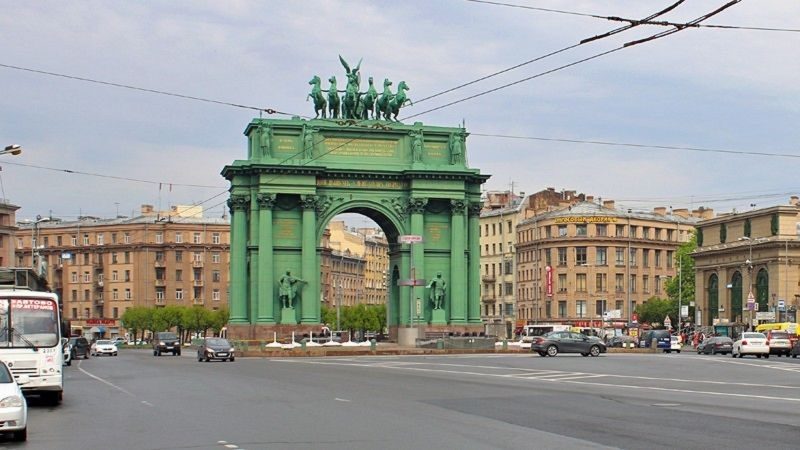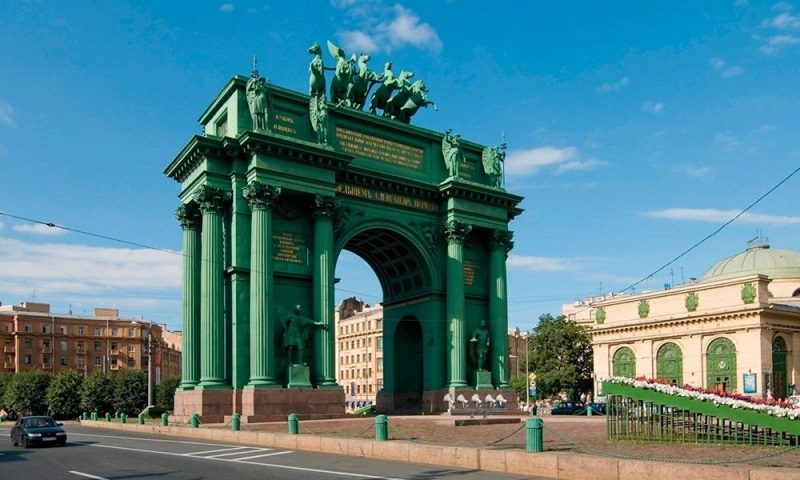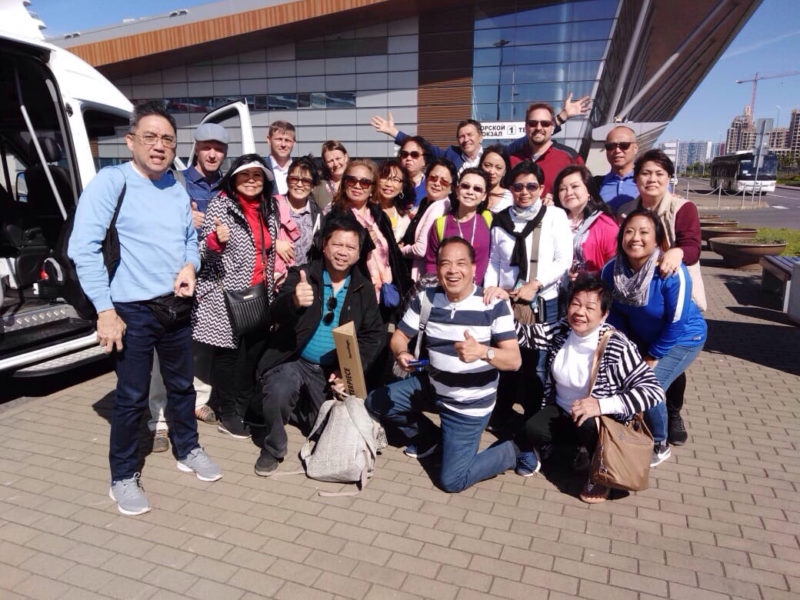Narva Triumphal Arch in St. Petersburg

Address: Ploshchad' Stachek, 1, St Petersburg
About
Initially, the monumental building, the Narva Triumphal Arch/Narvskaya Triumfalnaya Arka, intended for the solemn return of Russian troops after the victory over Napoleon in 1814, was erected at the Narva gate/Narvskaya zastava, near the border of the city near the Obvodnoy Canal. The Triumphal Arch of 1814 was built of wood and alabaster in just 1 month, immediately after receiving news of the end of the war.
The project of the monument belonged to the great Italian architect Giacomo Quarenghi, and the gate was decorated with plaster sculptures by I.I. Terebeneva. It was through this arch that the triumphal entry of the victorious regiments of the Russian army into Petersburg took place in the presence of the royal family and the inhabitants of the city.

A decade later, the dilapidated Narva Gate/Narvskiye vorota began to pose a danger and threatened to collapse. It was decided to disassemble the wooden monument. For the preservation of the historic monument, one of the generals of the Russian army during the Patriotic War, a member of the State Council of St. Petersburg, spoke M.A. Miloradovich Thanks to his intervention, he managed to get the sovereign's decision: "The Triumphal Gate, built in time, of wood and alabaster, made of marble, granite and copper."
The location of the future monument was chosen on the Peterhof Road to the south of the former place, on the bank of the Tarakanovka River, which is now buried.
A talented Russian architect, V.P. Stasov. The original design of Quarenghi was retained in the new project of the gate, the architect only increased the width of the arch and improved its decorative elements. A brick was chosen as the construction material and then sheathed with sheet copper.
On August 26, 1827, the foundation of the gate was laid on the 15th anniversary of the Battle of Borodino. 11 stones were laid at the bottom of the pit in the form of a cross. Gold coins, St. George's crosses and medals, which were then covered with a memorial plaque, were piled in the recesses between the plates. The solemn event was attended by members of the royal family and few honored prominent war veterans and city leaders.
On September 26, 1833, construction was announced.
Narva Gate is a typical architectural structure dedicated to the victorious completion of the military campaign - the Empire-style triumphal arch. At the top of the solemn monument is the main sculptural composition of the monument - the chariot drawn by six horses, ruled by the goddess of Victory Nick. In one hand, the goddess holds a laurel wreath, in the other - a palm branch.

Outstanding Russian sculptors worked on the horse composition: Stepan Pimenov is the author of the Victory statue, the creator of the six horses, P.K. Klodt, and the chariot is made according to the project of V. Demut-Malinovsky.
In the pylons of the gate between the columns of the Corinthian order (there are 12 of them altogether), figures of ancient Russian warriors, made according to the models of S. Pimenov and V. Demuth-Malinovsky, are installed. The height of the monument without a horse sculpture is 23 meters, its width is 28 meters, the width of the arch is more than 8 meters. The height of the columns adorning the arch is 10 m, and their diameter is 1 m.
On the western facade of the monument, the names of the guards cavalry regiments are listed in gold letters and the transition of the Russian army from Moscow to Paris is indicated. On the eastern facade are the names of infantry regiments and the places of the main battles (Borodino, Tarutino,Maly Yaroslavets, Krasnoe).
On August 17, 1834, on the 21st anniversary of the Battle of Kulm, the grand opening of the Narva Gate took place. The ceremony was attended by a large number of citizens, and under the arch the guards regiments, famous for their war, marched.
After 50 years it was necessary to repair the monument. It turned out that copper in the conditions of the St. Petersburg climate quickly corrodes (Nicholas I was right, insisting on building a monument of cast iron), and therefore it was decided to replace it with iron. However, after combining the design of two different materials, this process is further intensified. In 1925, a protracted and inefficient reconstruction of the gate, interrupted by the war that began in 1941, began. In 1945, the heavily damaged Narva Gate served as a triumphal arch when returning to the city after the victory of the Soviet troops.
The overhaul of the Narva Gate was completed in 1952. This was followed by repairs in 1980, and the last restoration of the monument was carried out on the eve of the 300th anniversary of St. Petersburg.
Inside the arch is a basement and three floors connected by spiral staircases.
These premises were previously used as a city archive. In 1987, the Museum was opened here, dedicated to the history of the construction of the monument, as well as the exhibition with attributes and materials from the history of the 1812 war.
The Narva Gate is located at the Stachek Square, at the Narvskaya metro station. The area around the triumphal gate was also designed by the architect V.P. Stasov.
Read more
- How to travel in Saint Petersburg without living your home
- Four of the ten best restaurants in the country are in St. Petersburg
- The first Holocaust museum in St. Petersburg
- A scientist from St. Petersburg created the biochronicle of Peter the Great.
- 10 interesting facts about Saint-Petersburg streets

Moderate 2 Day
Shore Excursion
St. Petersburg, Russia
from 241$